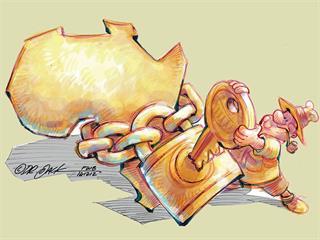
Before rushing to put their funds into African agriculture, investors would do well to come to grips with several macro-economic trends. Nowadays, Africa is often said to be the world’s final investment frontier. If I recall the statistics correctly, seven out of the 10 fastest-growing economies in the world are in Africa. But to what extent is this a sign of internal growth, driven by continually diversifying economies?
Diversification
For the past 10 to 12 years, Africa and China’s gross domestic product (GDP) have been perfectly correlated. When China grows, Africa grows. When China comes down, Africa comes down.
Why?
China is a resource-hungry economy and the manufacturing engine of the world. And its raw resources come from Africa.
We should therefore not misinterpret GDP growth in Africa as the rapid emergence of well-diversified economies. Moreover, it is known that China intends moving away from a manufacturing economy to a consumer- and service-based economy over the next 20 to 30 years. This poses the question: how will Africa be affected when its biggest client starts cutting down on consumption of its key products, namely minerals and oil?
The challenge for Africa is to use this commodity boom to diversify economies as quickly as possible. Take Angola as an example. The country is often cited as the second-fastest growing economy in Africa. A total of 97,5% of their export revenue comes from oil – a single commodity. Now imagine what the decline in the oil price – presently about $80 a barrel – is doing to its economy.
When its primary customer indicates that it will depend on Angola less and less, is it prepared? Is it making use of this resource bonanza to invest in infrastructure, education and health?
GDP often presents a skewed picture of reality.Where does the money Angola receives from its oil exports end up? It is unlikely it goes to the whole population; rather, it ends up in the hands of a few.
The whole picture
When investing in Africa, it is essential to know the facts. Future food demand will be very high. Africa will double its population in less than three decades. The continent has the best potential in terms of global arable land. All these are well known. But they are not the only ingredients required for successful agriculture in Africa.
Also important are:
- A well-diversified economy;
- Well-developed research, education and support institutions;
- Well-developed storage and transport logistics;
A progressive policy framework.
Without the above, and the empowerment of African farmers to farm commercially, the continent will be unable to provide food security for its own inhabitants, let alone become the bread basket of the world. In the 1970s, Africa was self-sufficient in food production. Since then, it has become a net importer of food; more so over the past decade, according to the Food and Agricultural Organisation.
From where we stand today, we can see this massive opportunity in food production. But we run the risk of arriving at 2044 having missed it, as we have done over the last 30 years.
Small-scale a no-go
How do we change this picture? South Africa has the greatest concentration of commercial farmers on the continent.
Controversial or not, agriculture potential will not be unlocked by small-scale farmers. It has not happened for 30 years and it will not happen in the future. What is the attraction of small-scale farming to the youth of Africa?
Dr Nkosazana Dlamini-Zuma, chairperson of the African Union, summed it up earlier this year: if there is 90% cellphone penetration, do we really expect to see a young African with a hoe in one hand and a cellphone in the other doing back-breaking work for 16 hours a day? It’s not going to happen.
The facts are stacked against small-scale farmers. Studies have shown that since 2015, small-scale farmers in Africa who export horticulture to Europe have declined dramatically, illustrating the harsh reality of supplying the demanding European supermarkets. These farmers simply cannot afford the quality controls and smart-farming techniques needed to meet those demands.
Land reform
There is broad consensus that the success of land transformation depends on a public-private partnership. Over the last few months, organised agriculture, the Banking Association of SA and Agbiz have been engaged in serious internal dialogue on how to move transformation forward. As commercial banks, we do not see ourselves as having all the answers; we can only play a commercial role. We do not have a development mandate. We cannot resolve the problems that only government can resolve.
We can, however, play a role in the commercial financing, should government find our proposals acceptable. At some point, we’d like to see the views of the public and private sectors converge. Of course, there will be compromises on the journey before a final agreement is reached.
In general, I’m positive about the progress that the agri-sector is making in land transformation. But in moving down this road of transformation, there is a risk of making reform projects unsustainable by introducing land ceilings. Why should a black farmer not own a 5 000ha dryland farm? Or own a 500ha fruit farm? Land ceilings will prevent this, and make economically viable units difficult to achieve. – Jaco Visser
Phone Brienne van der Walt on 011 350 3055.













